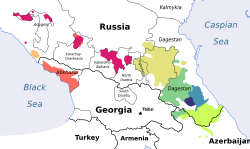This article has multiple issues. Please help improve it or discuss these issues on the talk page . (Learn how and when to remove these messages)
|
| Hunzib | |
|---|---|
| Gunzib | |
| гьонкьос мыцhonƛʼos mɨc | |
| Pronunciation | [ˈhont͡ɬʼosmɨt͡s] |
| Native to | North Caucasus |
| Region | Southern Dagestan |
Native speakers | 1,400 (2006–2010) [1] 3,466 (2020) [2] |
Northeast Caucasian
| |
| Cyrillic | |
| Language codes | |
| ISO 639-3 | huz |
| Glottolog | hunz1247 |
| ELP | Hunzib |
 Hunzib | |
 Hunzib is classified as Definitely Endangered by the UNESCO Atlas of the World's Languages in Danger (2010) | |
Hunzib is a Northeast Caucasian language spoken by the Hunzib people in the Tsunta and Kizilyurt districts of Dagestan and in two villages across the Russian border in Georgia. [3] Hunzib is not an official language, and it is rarely written. [4]

